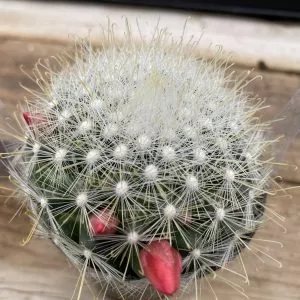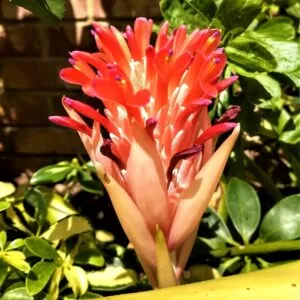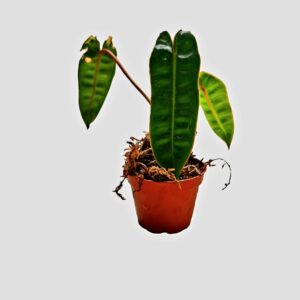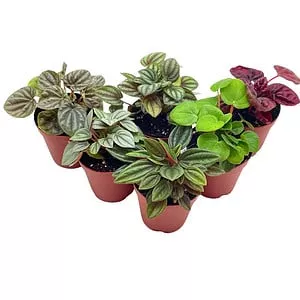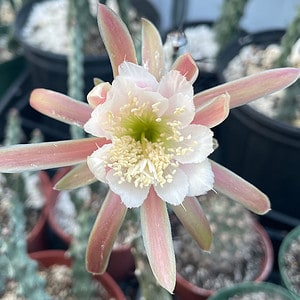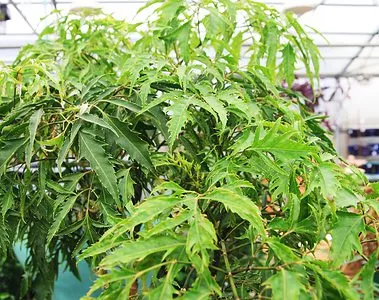No products in the cart.
Table of Contents
Regarding elegant and exotic houseplants, Anthuriums often steal the spotlight. Anthuriums are a favorite among plant enthusiasts with their stunning heart-shaped blooms and glossy, deep green leaves. Nonetheless, these plants require specific care to thrive indoors.
This guide will delve into what Anthurium plants are and how to keep your flowering houseplant alive.
What is Anthurium Plant?
Anthurium plants are a type of tropical plant that is native to South America. They belong to the Araceae family of plants and are known for their beautiful flowers. These plants are also called flamingo flowers or tail flowers because of the shape of their flowers.
Anthurium plants come in various colors, including red, pink, white, and purple. They are popular houseplants because of their glossy leaves and striking flowers. Anthurium plants are also used in landscaping and as cut flowers.
Anthurium plants belong to the Anthurium genus, which has more than 800 species. These plants are native to tropical regions of the Americas, from Mexico to Argentina. Anthurium plants are epiphytes, which means they grow on other plants.
They are also hemiepiphytes, which means they start their life cycle as a seed on the forest floor and then grow up to the canopy, where they start growing as an epiphyte. While you can grow them as outdoor plants in warm temperatures, you can also grow them indoors.
How to Care for Anthurium Plants
The flamingo flower thrives in bright light with partial shade as they do not enjoy direct sunlight. The only time the Anthurium loves direct light is in winter. So, with suitable soil, water, and light, you can ensure your plant will survive.
Ideal Soil Mix for Flamingo Flower

The Flamingo lily thrives in a well-draining soil rich in organic matter. When it comes to Anthurium care, it loves a soil mix that contains peat or coco coir. Peat moss retains moisture while also ensuring good aeration for the roots.
It contributes to the overall moisture retention in the soil, which is crucial for these tropical plants. You can also add some perlite to help improve drainage and prevent the ground from becoming overly compacted.
Then add some pine bark for added aeration and help with drainage. It is very beneficial when your Anthurium andraeanum is in a large pot. You can use sphagnum moss to line the bottom of the container to aid moisture.
Using a well-balanced mix of these components is essential to create an ideal soil environment for your Anthuriums. The mixture should allow the soil to stay consistently moist but not soggy.
Additionally, choose a pot with good drainage holes to ensure excess water can escape and prevent waterlogging. An excellent potting mix is an orchid mix available at most nurseries or online.
Light
The tail flower thrives in bright, indirect light. Providing the best light conditions for your Anthurium flowers is crucial to their growth and blooming. Place your tropical plants where they can receive bright, indirect light.
Generally, the best location for your indoor plants is a north or east-facing window. Here, they receive filtered light in the morning. The best is to avoid direct sun, which can result in brown leaf tips burning the foliage.
If you have strong, direct sunlight streaming through a window, consider using sheer curtains or blinds to filter the light. This helps create a dappled light effect similar to the rainforest floor. When grown outdoors, please provide them with the same light needs.
A note is to rotate your anthurium plants regularly for even growth and remember too much sunlight will damage the foliage. By providing the right balance of bright, indirect light, you can help your Anthurium produce those distinctive heart-shaped leaves and flowers and maintain its lush green foliage.
Watering Flamingo Flower
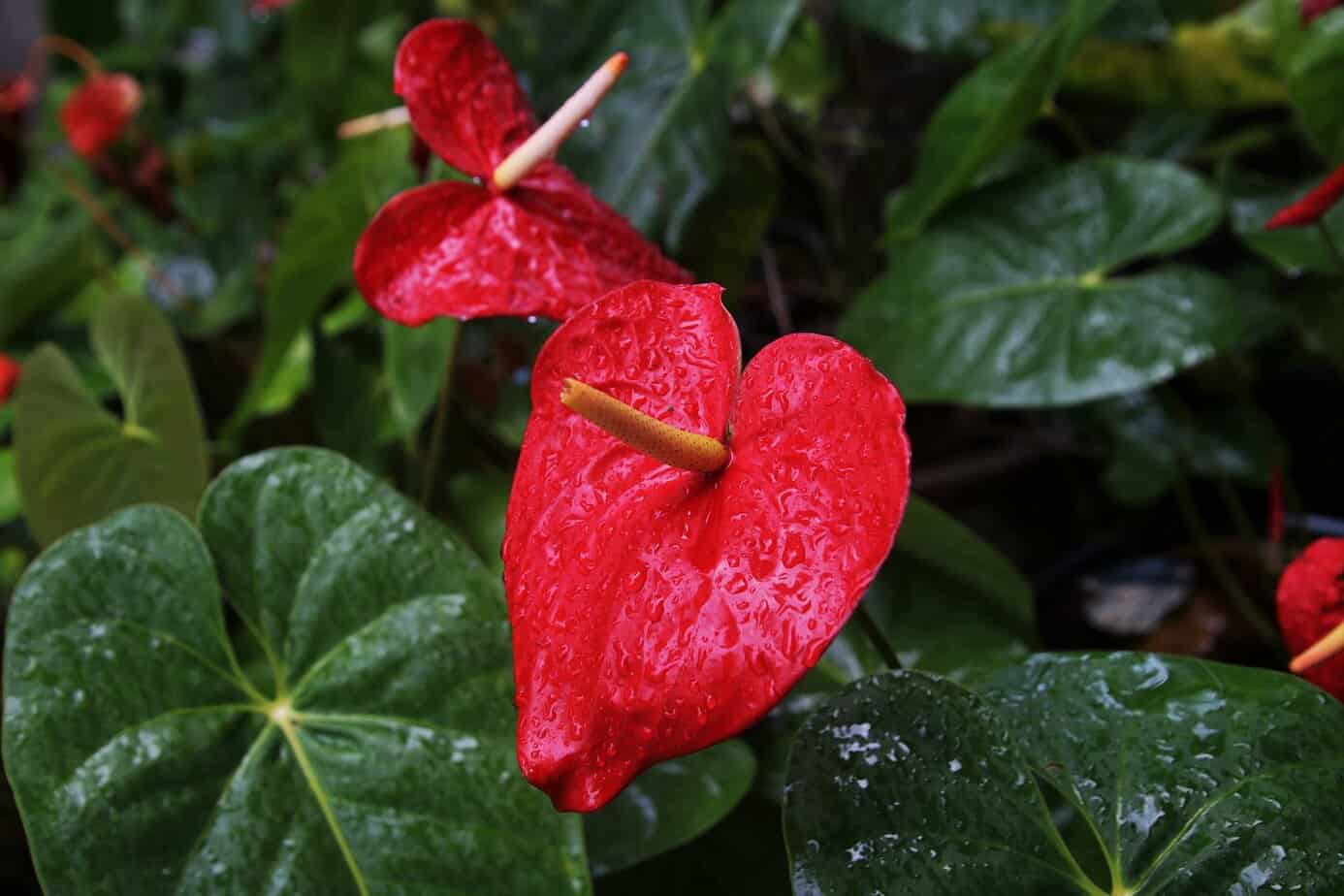
Anthurium grows best in moist soil but is not too wet and should not dry out completely. Hence, your Anthurium andraeanum needs regular watering. But an important note is not to overwater your flamingo flowers to avoid root rot.
So, to care for an Anthurium, it needs close monitoring to provide it with the proper care. A potting mix in a container with good drainage allows for moist soil without retaining too much moisture. Always leave the water to seep out of the tray and throw the excess water away.
When the soil surface is dry, you can water your plant again.
Temperature and Humidity Need
Your flower thrives in temperatures above 60° F, and some prefer warmer climates to flourish. Nonetheless, it will suffer when the temperature drops below the required level.
So, you can place your flamingo flower in a warm spot close to a sunny window with some dappled shade.
But keep your tropical plant away from draughts and radiators. The tail flowers thrive in a highly humid environment like a bathroom or work well to group plants to help raise moisture.
Alternatively, to provide high humidity, place your plant on a pebble tray with water or use a humidifier to create a humid environment.
Pruning
Pruning will help maintain the health, vitality, and appearance of Anthurium flowers. Begin by carefully inspecting your Anthurium for signs of damaged yellowing or brown leaves like brown tips.
Select the leaves you want to prune. These can be leaves that are yellow, brown, damaged, or simply older leaves. Be sure not to remove too many leaves at once, as this can stress the plant.
If you’re concerned about pruning specific blooms, remember that the colorful part of Anthurium flowers is not a flower but a modified leaf called a spathe.
It’s best to leave these intact to enjoy the plant’s unique appearance. Pruning can be done year-round as needed, but avoid heavy pruning during the plant’s dormant period, typically in late winter or early spring.
Fertilizing Anthurium

We recommend using a liquid feed during the growing season of spring and summer. You can use a fertilizer high in phosphor diluted to a quarter of strength to feed your plant every week. The rich phosphorus content will encourage blooms.
Anthurium Care When Repotting
The ideal time to repot your Anthurium is in the spring or early summer when the plant is actively growing. Avoid repotting during its dormant period, which usually occurs in late winter.
Select a new pot that is only slightly larger than the current one. Anthuriums prefer to be somewhat root-bound, and a pot that’s too large can lead to overwatering. Make sure the new pot has drainage holes to prevent waterlogged soil.
Examine the root ball for rot, damage, or overcrowding. If you see unhealthy Anthurium roots, trim them with clean shears or scissors. This helps the plant redirect its energy to healthy roots. Give your plant a thorough watering to settle the soil and hydrate the plant.
Use room-temperature water and stop when water drains from the drainage hole. Before returning the pot to medium light, please wait until the excess water drains.
-
$59.99Sold By: BubbleBlooms
In stock
Huernia Stapelia Combo Bundle Variety Pack, Starfish Lifesaver Cactus, Red Dragon, & Black Bells Flower schneideriana, zebrina, leendertziae
Rated 4.81 out of 5 based on 279 customer ratings00Sold By: BubbleBlooms -
$15.99Sold By: Succulent Oasis
Only 1 left in stock
Cactus Plant. Medium Mammillopisis Senilis.
Rated 4.84 out of 5 based on 352 customer ratings03Sold By: Succulent Oasis -
Free Shipping$9.96Sold By: CZ Grain
In stock
50 Red Maple Tree Seeds | Stunning Red Leaves
Only 891 available and it’s in 2 people’s basketRated 4.60 out of 5 based on 156 customer ratings00Sold By: CZ Grain -
Free Shipping$8.98Sold By: CZ Grain
In stock
gigantic pumpkin seeds
Rated 4.60 out of 5 based on 156 customer ratings00Sold By: CZ Grain
How to Propagate Your Anthurium
So, when do you know you can propagate your Anthurium plant? Well, they will send out fleshy aerial roots and appear knobby. The roots will jot out from the stem above the soil at any time.
It helps to propagate your plant if it has stopped blooming or you notice a decrease in the blooms. Hence, you can use root cuttings or even stem cuttings. To do this, you need a sterilized pot with enough drainage holes.
You can also use an optional rooting hormone. Next, cut off the air roots with sharp pruning shears or select a six-inch-long stem with three sets of leaves. Dip the cut end into the rooting hormone and plant that end into the potting mix and keep the soil moist.
Place your container in a warm spot with indirect light and prevent soggy soil. You should notice new roots and growth in about four weeks.
Anthurium Varieties
The Flamingo flower is not the only Anthurium species you can find; some other plants in the family make great indoor plants.
Anthurium sherzerianum
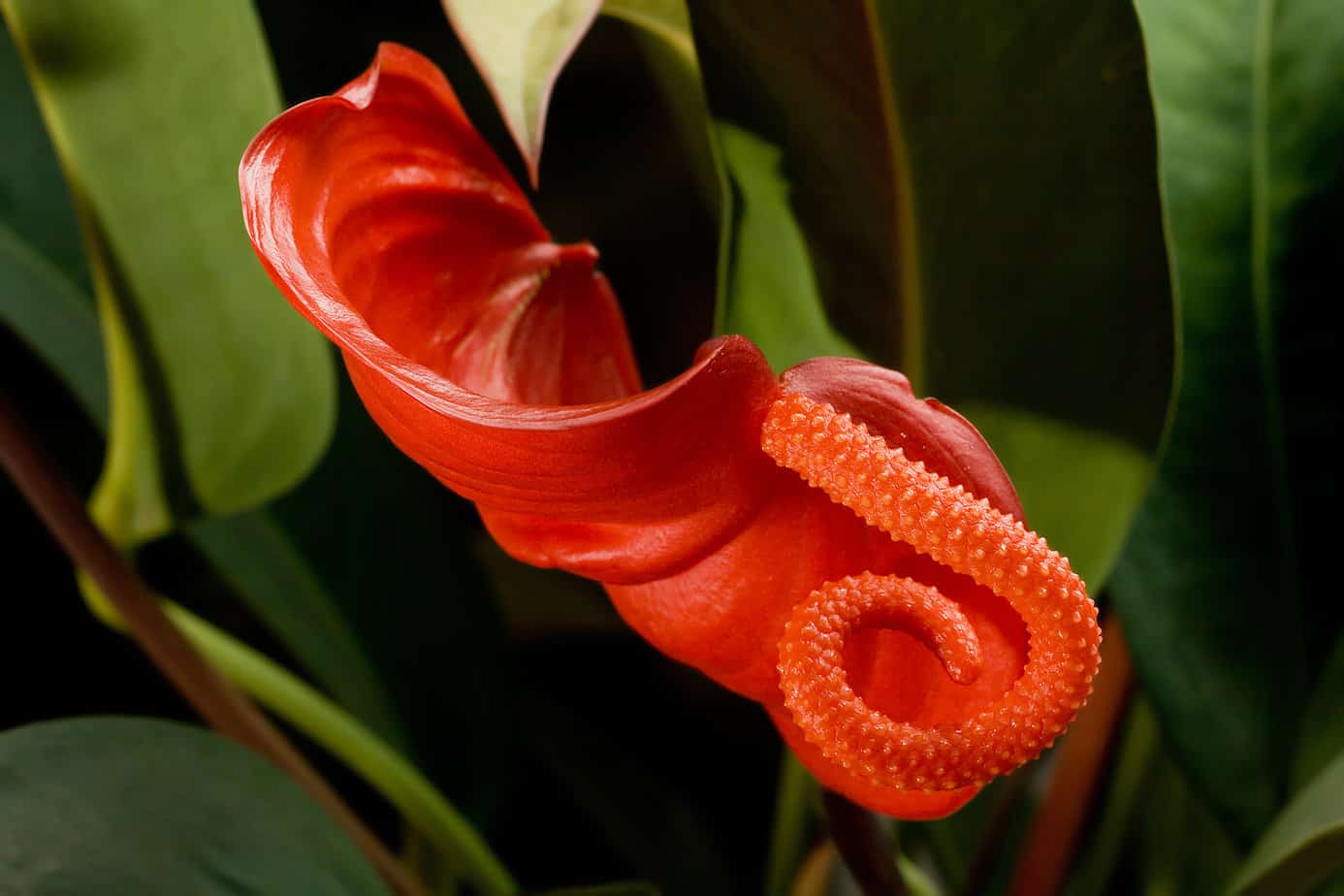
It is a forgiving species with curling orange flowers on spikes and arrow-shaped leaves.
Anthurium crystallinum
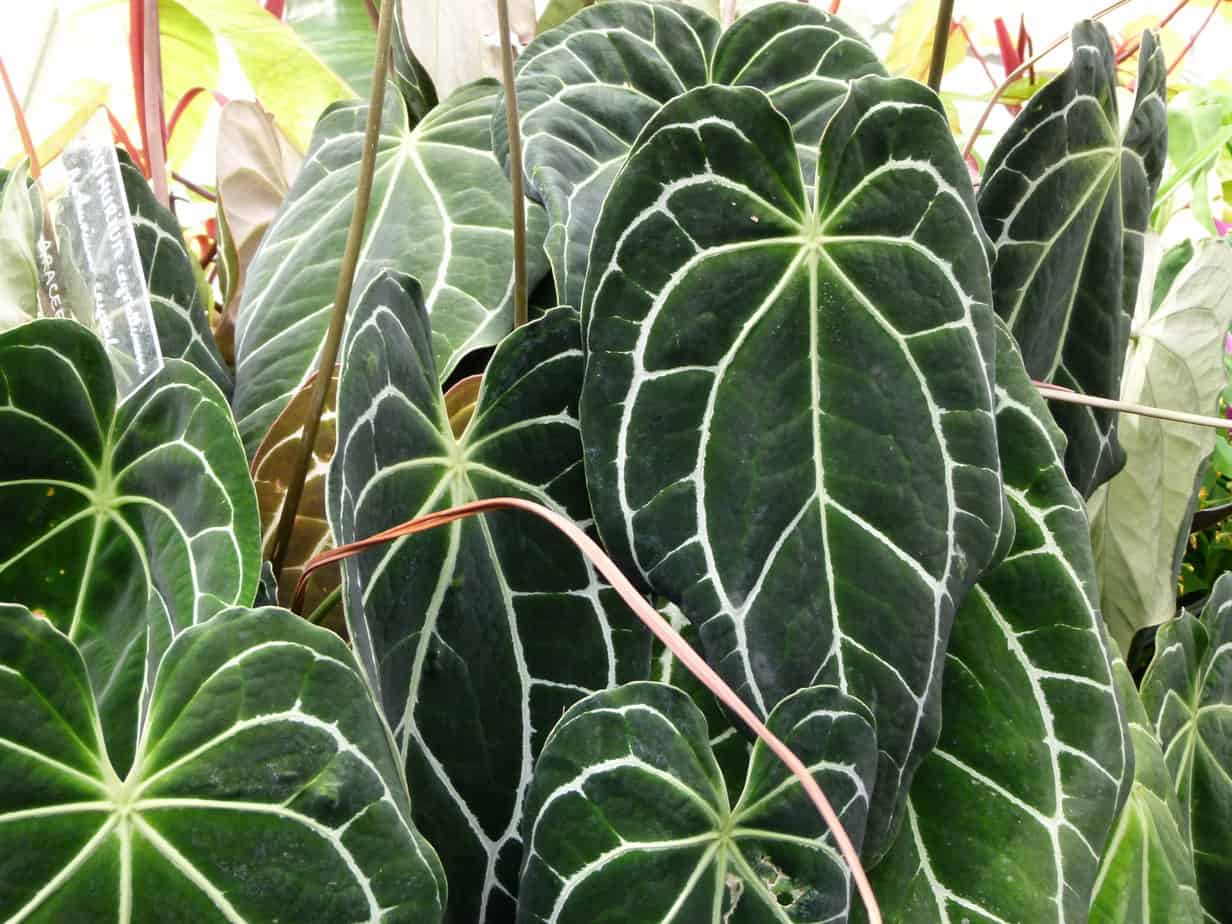
It is a less common species with a deep green velvet leaf with white ribs. The leaves can grow up to two feet across.
Anthurium faustinomirandae
The plant has monster–sized leaves that are cardboard-stiff, growing up to five feet long. It is an exclusive greenhouse plant.
Anthurium clarinervium
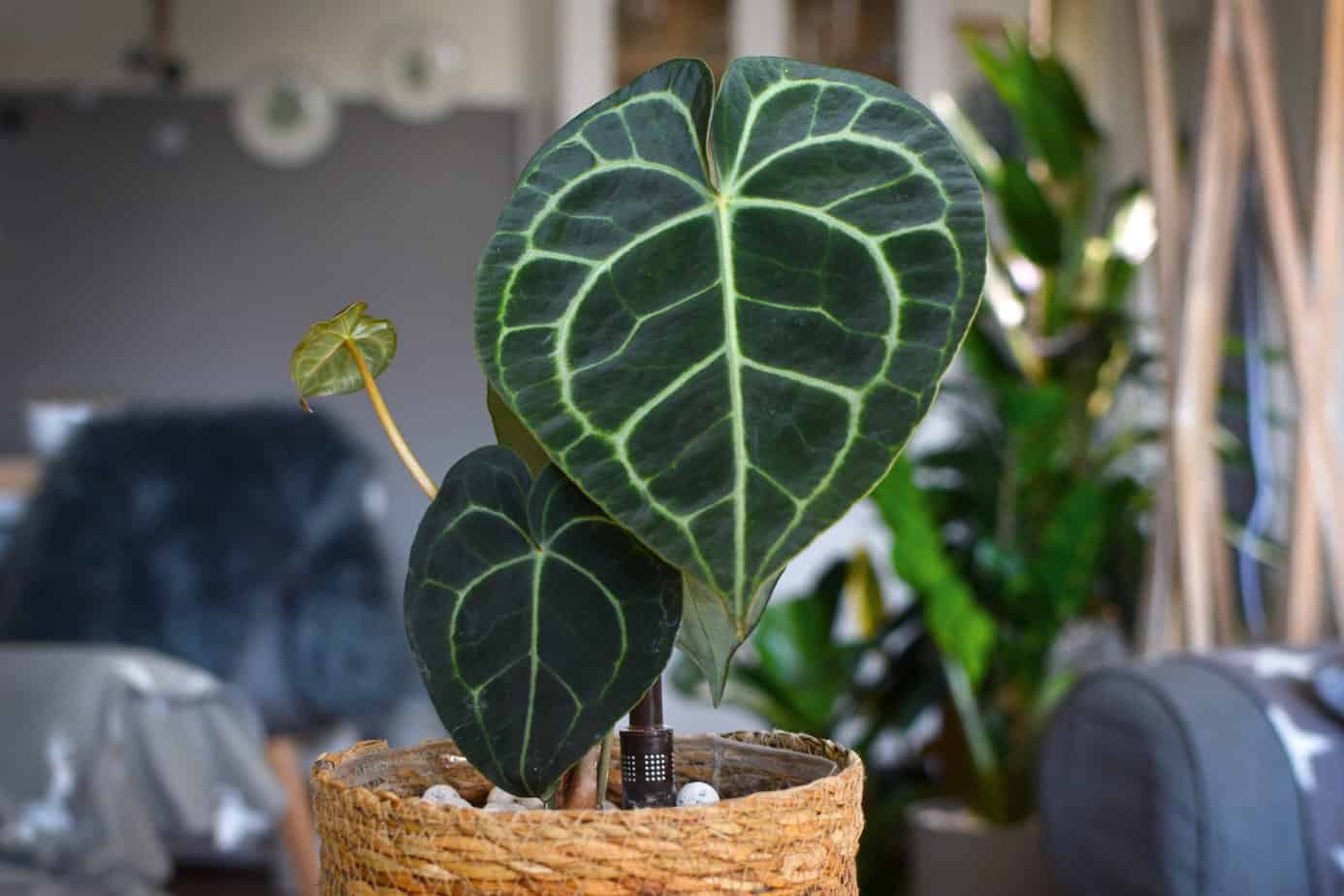
The plant is grown for its spectacular foliage: dark green with white veins and a pink spadix.
Common Pests and Diseases
As with most houseplants, when it comes to Anthurium care, spider mites, scale, whiteflies, and mealybugs can bug it. If you find a trail of ants on the leaves, it is a sign of an aphid infestation as they feed on the sticky residue.
If the leaves look yellow, they can be from spider mites, while thrips can cause molted leaf-like mealybugs. You can often control these pests with a sharp blast of water to dislodge them. You can then remove the dead foliage to prevent the spread of diseases.
Removing the dead leaves will help the plant focus on new growth. If they are stubborn, a horticultural soap or neem oil spray can help remove them naturally. Other concerns are yellowing leaves resulting from too much light. You can move your plant away from the window.
Yellowing leaves can also result from bacterial wilt, and the stem color will change to yellow or bronze. If your plant is not getting enough light, the glossy green will change to dark green.
Frequently Asked Questions
Water your Anthurium when the top inch of soil feels dry, typically every 1-2 weeks.
Anthuriums prefer bright, indirect light but can tolerate lower light levels. However, they may not bloom as prolifically in low light.
Regularly inspect your plant for signs of pests and apply insecticidal soap or neem oil as needed. Isolate any infested plants to prevent spreading
Anthuriums thrive as indoor plants but can grow outdoors in warm, high-humidity tropical climates with filtered light.
Yellowing leaves can indicate overwatering or inadequate light with fewer flowers. Adjust your care routine accordingly to address the issue.
Yes, it helps to remove the spent flowers as it helps encourage continuous blooming.
Whether you want to buy, sell or simply reach out to other plant enthusiasts, Plantly is the right place to be!
In stock (can be backordered) In stock In stock In stock
Free Shipping
$21.99
Sold By:
Gar-Zen Botanical Design
Bromeliad Flaming Torch billbergia Ships Free
Only 6 available and it’s in 1 people’s basket Rated 4.86 out of 5 based on 49 customer ratings00
Sold By:
Gar-Zen Botanical Design
$12.00
Sold By:
PotHedz Plants
Philodendron billietiae
Rated 4.96 out of 5 based on 106 customer ratings00
Sold By:
PotHedz Plants
$24.99
Sold By:
BubbleBlooms
$29.99Peperomia Assortment, Foliage set, rosso, frost, albovittata, caperata, premium succulent collection, in 2 inch pots, plant gift
Only 6 available and it’s in 1 people’s basket Rated 4.81 out of 5 based on 279 customer ratings00
Sold By:
BubbleBlooms
$18.00
Sold By:
Beauties & Beasts
Cactus – Monvillea spegazzinii
Only 2 available and it’s in 1 people’s basket Rated 4.83 out of 5 based on 24 customer ratings00
Sold By:
Beauties & Beasts

